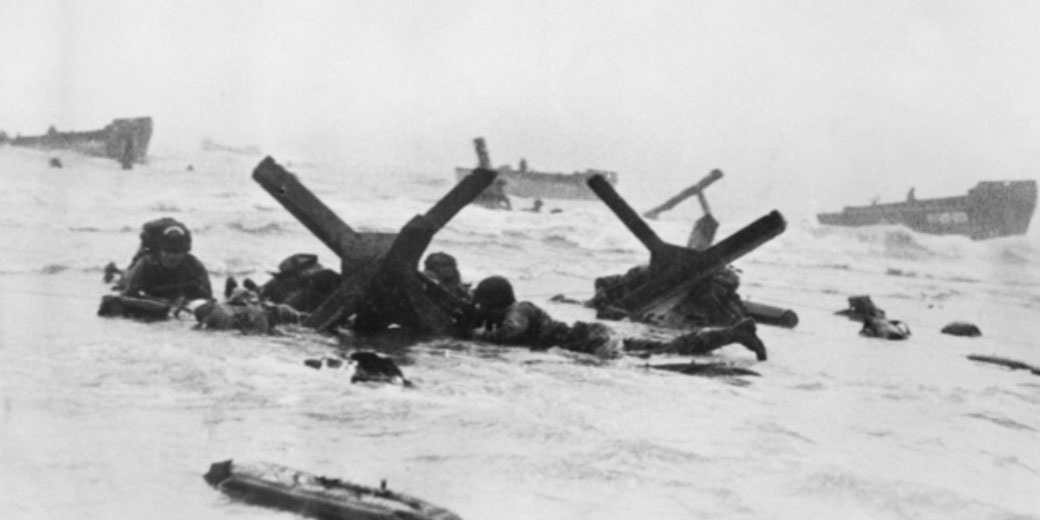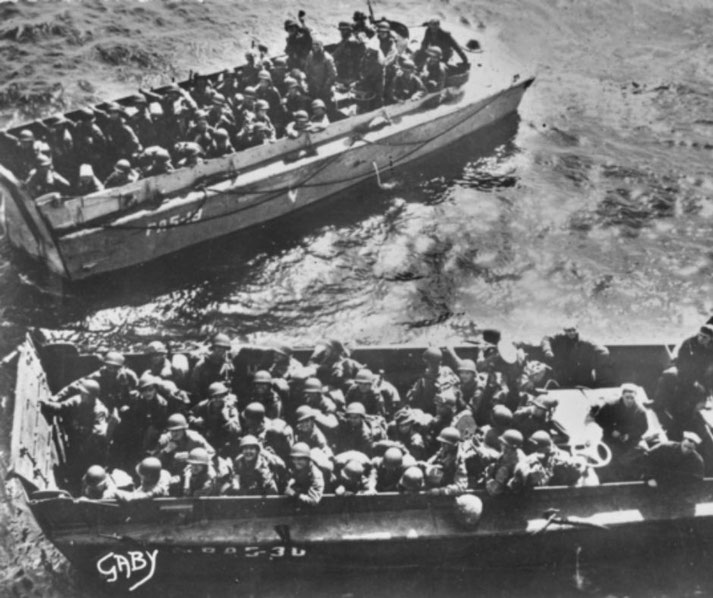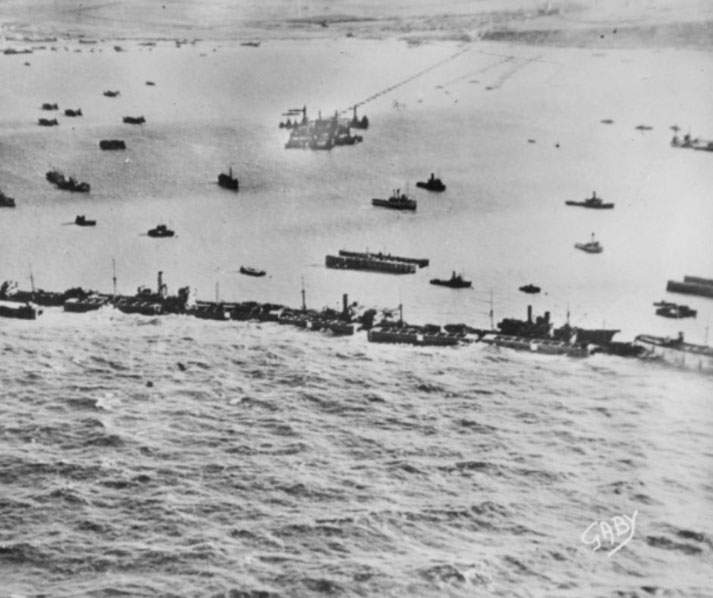Why Omaha Beach was the bloodiest of the D-Day landings

On June 6, 1944, thousands of Allied troops stormed the beaches of Normandy in a daring and unprecedented amphibious assault aimed at freeing Europe from Nazi dominance.
Among these beaches, Omaha Beach is famous for its harrowing fight and crucial victory. This historic battle was a profound display of human courage and resilience in the face of staggering odds.
But what were the strategic reasons behind selecting Omaha Beach for the landing?
What challenges did the Americans overcome on that fateful day?
And what sacrifices did they make to secure a foothold in Nazi-occupied Europe?
Why did the Americans land at Omaha Beach?
The strategic significance of Omaha Beach in the D-Day operation lay in its geographical position and the role it was to play in the broader Allied strategy.
Omaha, one of five designated beaches for the invasion, was situated between Utah Beach to the west and British and Canadian landing sites to the east.
Securing Omaha was crucial for linking the American landings on Utah Beach with the British landings on Gold, Juno, and Sword beaches, thus ensuring a continuous Allied front along the Normandy coast.
This was essential for the success of Operation Overlord, which aimed not just at breaching the German defenses but also at establishing a strong, unified beachhead for further advancement into occupied France.
The capture of Omaha Beach was also vital for the Allies to access major ports, particularly Cherbourg to the northwest. Cherbourg was key for logistical support, necessary to sustain the Allied forces as they pushed inland.
The successful landing at Omaha would enable the Allies to quickly capture Cherbourg and secure a critical supply line for the advancing troops.
Planning and preparations for the landing
The decision to invade Normandy was taken at the Trident Conference in Washington D.C. in May 1943, and General Dwight D. Eisenhower was appointed as the Supreme Commander of the Allied Expeditionary Force.
The chosen date for the invasion, initially set for May 1944, was later postponed to June due to various factors, including the need for more landing craft and favorable weather conditions.
A critical component of the preparation was gathering intelligence on German fortifications along the Normandy coast.
The Allies conducted reconnaissance missions, including aerial photography and gathering information from the French Resistance.
This intelligence was crucial in planning the assault, especially in understanding the formidable German defenses built as part of the Atlantic Wall.
Troops underwent specialized training for amphibious landings and assault on fortified positions.
Mock drills were conducted, including full-scale rehearsals with naval and air support, notably Exercise Tiger in April 1944, which, despite being marred by a tragic incident involving German E-boats, provided valuable lessons.
Logistical preparation was a massive undertaking. The Allies amassed a vast armada of over 6,900 vessels, including transports, landing crafts, and warships.
In addition, they developed innovative technologies and equipment, such as the Mulberry harbors (portable temporary harbors) and the ‘Hobart's Funnies’ (specially adapted tanks for various engineering tasks).
These innovations were crucial in overcoming the challenges posed by the heavily fortified beaches and the lack of port facilities.
The final plan, codenamed Operation Neptune, was the naval component of Operation Overlord, the overall plan for the invasion of Normandy.
It involved detailed timings for the landings, coordinated with aerial and naval bombardments.
The decision to go ahead with the operation on June 6, 1944, was taken by Eisenhower on the basis of weather reports predicting brief improvement in conditions.
This window of opportunity was crucial, as the success of the operation depended heavily on the elements, including the tides and the moon phase.
The American forces who landed on Omaha
The forces involved in the assault on Omaha Beach were predominantly from the United States Army, constituting a significant part of the larger Allied effort on D-Day.
The primary units tasked with the initial landings at Omaha were the 1st Infantry Division, nicknamed "The Big Red One," and the 29th Infantry Division, known as the "Blue and Gray."
These divisions were chosen for their combat experience and proficiency in amphibious operations.
The 1st Infantry Division, commanded by Major General Clarence R. Huebner, was a seasoned unit with previous combat experience in North Africa and Sicily.
Its soldiers were among the first to land on Omaha Beach, tasked with securing the eastern half of the beach.
The 29th Infantry Division, led by Major General Charles H. Gerhardt, was a National Guard unit with soldiers primarily from Maryland, Virginia, and the District of Columbia.
Although less experienced than the 1st Division, the 29th was intensively trained and prepared for the operation.
In addition to these divisions, several specialized units played crucial roles in the Omaha Beach landings.
The 2nd and 5th Ranger Battalions, under the command of Lieutenant Colonel James Earl Rudder, were assigned the daunting task of scaling the cliffs at Pointe du Hoc, west of Omaha, to neutralize German artillery positions that threatened the landing beaches.
The Navy provided substantial support with battleships, destroyers, and other vessels delivering pre-landing bombardment to weaken German defenses.
The USS Texas and USS Arkansas, among others, played critical roles in this effort.
The Air Force also had a significant role, with the 8th Air Force conducting bombing runs to target German defenses and disrupt transportation routes.
However, the effectiveness of these bombings was limited due to poor weather and the need to avoid hitting the advancing Allied troops.
The German forces defending Omaha Beach were part of the 352nd Infantry Division, commanded by Major General Dietrich Kraiss.
This division, although not the most elite of the German forces, was well-entrenched and had fortified the coast with bunkers, gun emplacements, mines, and obstacles as part of the Atlantic Wall defenses.
What happened on the day of the landings?
The operation began in the early hours of the morning, under the cover of darkness, with preliminary bombardments from the air and sea aimed at softening German defenses.
However, due to factors such as poor visibility and the desire to avoid hitting French civilians, the bombing was less effective than hoped, leaving most of the German fortifications intact.
As dawn broke, the first wave of infantry, primarily from the 1st and 29th Infantry Divisions of the United States Army, began to land at around 6:30 AM.
They were transported to the beaches in Higgins boats, a type of landing craft specifically designed for such operations.
The plan was to land at low tide to expose obstacles and mines planted by the Germans, but this also meant that the soldiers had to cross a larger expanse of beach under heavy enemy fire.
The troops landing on Omaha Beach faced immediate and intense opposition. German gunfire from well-fortified positions, including machine guns and artillery, inflicted heavy casualties.
The rough seas caused many landing craft to miss their targets, and some soldiers drowned due to the weight of their equipment or were hit by enemy fire before even reaching the shore.
The beach was soon strewn with damaged vehicles, equipment, and casualties, adding to the chaos.

The horrific challenges facing the Americans
One of the primary challenges was the unexpectedly strong German defense.
The Allies had anticipated facing a less formidable enemy force; however, they encountered the well-trained and equipped 352nd Infantry Division.
This division, unlike the static defense troops the Allies expected, was experienced and capable of a robust defense.
The natural terrain of Omaha Beach itself posed significant difficulties. The beach had a gentle slope, which, combined with a rising tide, rapidly reduced the available landing area.
The soldiers had to cross a wide stretch of beach under heavy enemy fire, making them vulnerable targets.
Additionally, the beach was bordered by steep cliffs and bluffs, which the Germans had effectively fortified with machine-gun nests, artillery positions, and mortars, creating a lethal crossfire zone.
Poor weather conditions and the need to avoid civilian casualties led to many bombs and shells landing too far inland, leaving German fortifications on the beach largely intact.
This meant that the landing troops faced much stronger resistance than anticipated.
Moreover, rough seas and strong currents disrupted the landings. Many landing craft were swamped or capsized, leading to the loss of men and equipment before reaching the shore.
The rough conditions also caused disorganization and scattering of landing units, leading to confusion and a breakdown in command and control structures upon reaching the beach.
Many units landed far from their intended targets, and key equipment, such as radios and vehicles, was lost in the chaos.
Individual acts of heroism and their impacts
The soldiers, many of whom were experiencing combat for the first time, demonstrated remarkable bravery in the face of overwhelming odds and lethal enemy fire.
From the moment the first landing crafts opened their ramps, soldiers were subjected to intense gunfire from well-entrenched German positions.
Many were killed or wounded before they could even disembark. Despite this, the survivors pressed forward, wading through the surf and navigating a landscape littered with obstacles and fallen comrades.
Medics, under constant fire, attended to the wounded, sometimes sacrificing their own safety to save others.
Engineers, tasked with clearing paths through the beach defenses, worked diligently amidst the chaos to enable vehicles and additional troops to land.
Individual soldiers, recognizing the need for leadership amidst the disarray, took initiative to rally their peers and lead assaults on German positions.
One notable example was First Lieutenant Jimmy Monteith, who led a group of men to take out several enemy positions before being killed in action.
His actions, for which he was posthumously awarded the Medal of Honor, were emblematic of the selfless courage displayed by many on that day.
The operation's success depended on the collective effort of every soldier, sailor, and airman involved.
The coordination of naval bombardment, the delivery of troops and supplies under fire, and the post-landing evacuation and care of the wounded were all critical components of the operation that required courage and resilience.

How many people died at Omaha Beach?
The casualties and losses sustained during the assault on Omaha Beach were among the heaviest experienced on any single day of World War II by American forces.
The exact number of casualties has been a subject of historical debate, but it is widely acknowledged that the losses were staggering.
On June 6, 1944, the American forces at Omaha Beach suffered approximately 2,000 to 4,000 casualties, with the higher estimates including those killed, wounded, missing, or taken prisoner.
Many of the casualties occurred in the opening moments of the landing. Soldiers, laden with heavy equipment, faced a deadly combination of obstacles, mines, and concentrated enemy fire.
For some units, the casualty rate was particularly high. For instance, Company A of the 116th Infantry Regiment, 29th Division, which landed at the strongest point of German resistance, suffered devastating losses, with only a few dozen of its initial 230 men able to continue the fight.
The rough seas and strong defenses claimed numerous landing craft and tanks, some of which sank before reaching the shore, adding to the chaos and loss of life.
Medical personnel, tasked with treating the wounded under fire, also suffered casualties, complicating the efforts to evacuate and care for the injured.
Why Omaha Beach was a significant event in WWII
The successful landing at Omaha, despite the heavy casualties and initial setbacks, was vital for establishing a continuous Allied front along the Normandy coast.
It enabled the linking of the American forces landing at Utah Beach with the British and Canadian forces landing on Gold, Juno, and Sword beaches.
This unity was crucial for maintaining a solid and expansive beachhead, from which the Allies could launch further operations into occupied France.
The capture of Omaha Beach also opened the way for the Allies to advance towards key strategic objectives.
One of the most important was the port of Cherbourg, which was essential for logistical support as the Allies pushed inland.
Securing a major port was crucial for maintaining the flow of troops, equipment, and supplies, all necessary for the sustained campaign against German forces in France.
For the German forces, the loss of Omaha Beach, along with the other D-Day beaches, signified a critical failure in repelling the invasion and marked the beginning of a steady retreat across Western Europe.
In a broader sense, the Omaha Beach landing underscored the effectiveness of Allied cooperation, planning, and execution under the most challenging conditions.
It was a demonstration of the collective military effort of multiple nations, each contributing to a complex and difficult operation.
The lessons learned in terms of amphibious assault tactics, coordination between air, sea, and land forces, and overcoming fortified positions had lasting implications for military strategy.
What do you need help with?
Download ready-to-use digital learning resources
Copyright © History Skills 2014-2025.
Contact via email
With the exception of links to external sites, some historical sources and extracts from specific publications, all content on this website is copyrighted by History Skills. This content may not be copied, republished or redistributed without written permission from the website creator. Please use the Contact page to obtain relevant permission.





